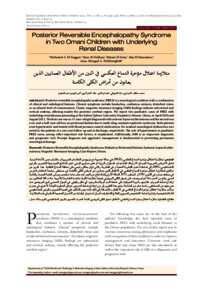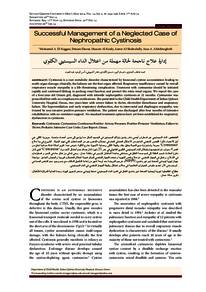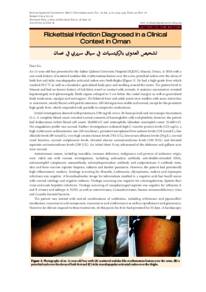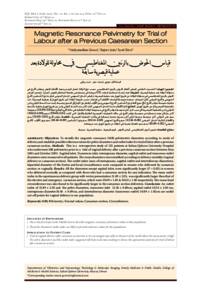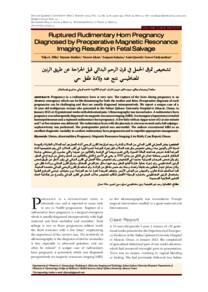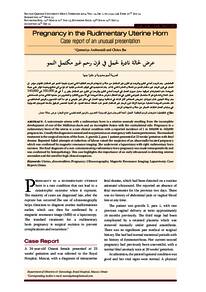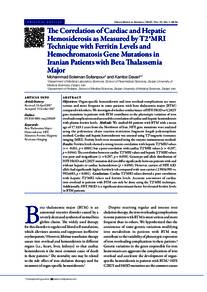Document
Posterior reversible encephalopathy syndrome in two Omani children with underlying renal diseases.
Identifier
DOI: 10.18295/squmj.2015.15.03.020.
Contributors
Al-Nabhaniyah, Dana., Author
El-Nour, Ibtisam., Author
El-Manzalawy, Alaa., Author
Abdelmogheth, Anas-Alwogud A., Author
Other titles
متلازمة اعتلال مؤخرة الدماغ العكسي في اثنين من الأطفال العمانيين الذين يعانون من أمراض الكلى الكامنة
Publisher
College of Medicine, Sultan Qaboos University.
Gregorian
2015-08
Language
English
Subject
English abstract
Posterior reversible encephalopathy syndrome (PRES) is a neurological condition with a combination of clinical and radiological features. Clinical symptoms include headaches, confusion, seizures, disturbed vision or an altered level of consciousness. Classic magnetic resonance imaging (MRI) findings indicate subcortical and cortical oedema, affecting mainly the posterior cerebral region. We report two paediatric cases of PRES with underlying renal diseases presenting at the Sultan Qaboos University Hospital in Muscat, Oman, in April 2010 and August 2011. The first case was an 11-year-old girl diagnosed with systemic lupus erythematosus and the second was a six-and-a-half-year-old boy on peritoneal dialysis due to multi-drug-resistant nephrotic syndrome. Both patients were hypertensive and treated with blood pressure control medications. No residual neurological dysfunction was noted in the patients at a one-year follow-up and at discharge, respectively. The role of hypertension in paediatric PRES cases, among other important risk factors, is emphasised. Additionally, MRI is an important diagnostic and prognostic tool. Prompt diagnosis and aggressive management is fundamental to preventing permanent neurological damage.
Member of
Resource URL
Citation
El-Naggari, Mohamed A., Al-Nabhaniyah, Dana, El-Nour, Ibtisam, El-Manzalawy, Alaa, & Abdelmogheth, Anas-Alwogud A. (2015). Posterior Reversible Encephalopathy Syndrome in Two Omani Children with Underlying Renal Diseases. Sultan Qaboos University Medical
Arabic abstract
متلازمة اعتلال مؤخرة الدماغ العكسي (PRES) هي حالة عصبية مع مزيج من العلامات السريرية وعلامات صور الأشعة السينية. تشمل الأعراض السريرية الصداع، الارتباك، التشنجات، اضطراب الرؤية أو تغير مستوى الوعي. تشير النتائج النموذجية للتصوير بالرنين المغناطيسي (MRI) إلى استسقاء تحت القشرية المخية و في القشرية، والتي تؤثر بشكل رئيسي على منطقة الدماغ الخلفية. هذا تقرير عن حالتين لمتلازمة اعتلال مؤخرة الدماغ العكسي في الأطفال الذين يعانون من أمراض الكلى الكامنة في مستشفى جامعة السلطان قابوس في مسقط، عمان، في أكتوبر 2010 و أغسطس 2011. الحالة الأولى لفتاة تبلغ من العمر أحد عشر عاما شخصت بمرض الذئبة الحمراء والثانية لصبي يبلغ من العمر ستة أعوام ونصف على غسيل الكلى البريتوني نتيجة متلازمة كلوية متعددة المقاومة للأدوية. عانت كلا الحالتين من ارتفاع ضغط الدم وتم علاجهم بأدوية للسيطرة على ضغط الدم. لم يلاحظ وجود أي خلل وظيفي في الجهاز العصبي لدى المريضين عند خروجهم من المستشفى و لمدة عام من المتابعة. يشير هذا التقرير إلى دور ارتفاع ضغط الدم بين عوامل الخطورة الهامة الأخرى في حدوث حالات متلازمة اعتلال مؤخرة الدماغ العكسي في الأطفال. بالإضافة إلى ذلك، فإنه يجب التأكيد علي أهمية التصوير بالرنين المغناطيسي كأداة تشخيصية وإنذارية هامة. التشخيص السريع والعلاج الفاعل هما أمران أساسيان لوقاية من الأضرار العصبية الدائم في هذه المتلازمة.
Category
Journal articles

